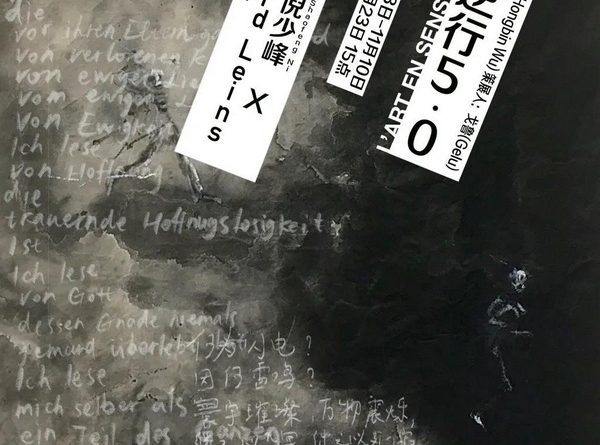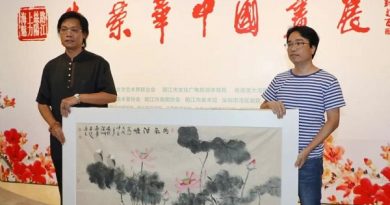”艺术逆行5.0“双个展北京闭幕
戈鲁
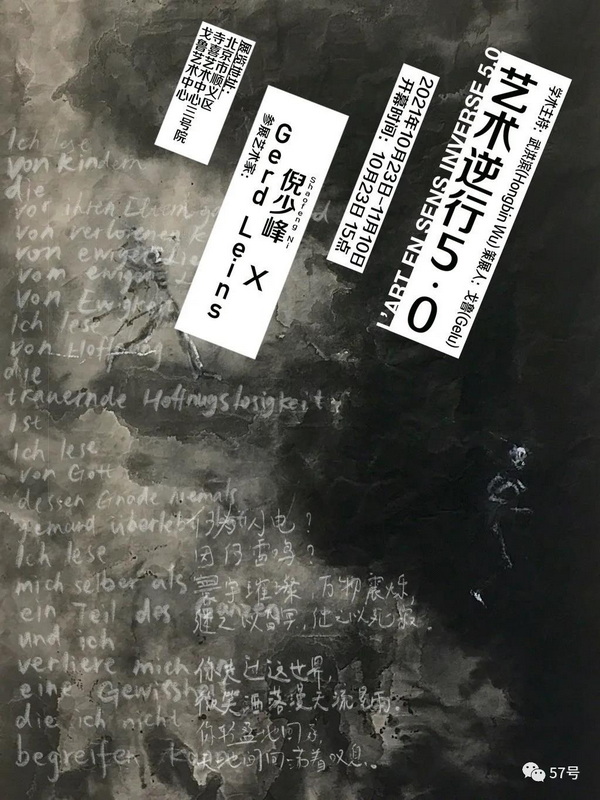
前言
旅德艺术家倪少峰先生和德国艺术家盖特兰斯先生的双个展“艺术逆行5.0”所展示的艺术主题是:关涉生与死的思考和叩问。面对死亡,我们每个人都无可推诿,人人都需要警醒。原来人生如此热闹喧嚣繁华,但是面对死亡,孤独被彰显出来了。死亡将人类逼进孤独的境地。文化,艺术,哲学,经济,财富地位所有的一切都无能为力!两位艺术家用他们的作品给出了一个永恒的话题。值得我们去反思考问…在黑与白的作品里,有着怎样的隐喻:死亡,希望,尊严,纪念,神秘莫测,孤单无助…救赎!
这即是个体的情感生命的体验和宣泄
也是群体共同意识的出口
我们如何胜过自己
我们如何走过生跨入死亡死亡就是终结吗
尤其在人类共同遇到这个疫情所至的至暗时刻
黑色象死亡重金属一样铿锵有力
我们该如何面对生思想死
从2020年伊始,一个小小的病毒让全世界处于同一个境地,那就是直面死亡,世界摁了暂停键……“死亡再次现形,梦想被剥夺,理智被耗尽”,艺术在此逆行一一旅德艺术家倪少峰和德国艺术家盖特兰斯或许会让你从新审视自己以及思考生死和当下。
那么就盖特兰斯先生此次艺术逆行5.0所展出的作品的题材和主题有那些特别之处呢?
盖特兰斯的作品是观念性的。
其创作的主题是:旨在寻找人类的普世的终极关怀,人与人本体的平衡关系。人到死亡这一步已经变得抽象,反观活着此在,倒显出了虚空的本质;人终有一死,死后终将被遗忘,人生的意义到底是什么?兰斯在创作的形式表达上采用了为人类所熟知的 十字架做为视觉符号,诠释了作品的十字架符号的指向和隐喻,以及作品的黑与白的关系的核心是,最终消逝的自我,而生命穿插在"无"之间的一个片刻。在这个片刻里是我们的自我意识。这个片刻是一个孤独的时间段——通过周围的人存在使得让我们的自我存在得以确认。
盖特兰斯的作品就表达方式而言,它分为 4四个阶段即四个部骤完成。首先将讣告贴于亚麻布上。
第一阶段: 逝者的姓名和出生日期会被黑色颜料抹去。黑色,象征着逝者最终成为的“无”。当人们仔细观察作品时,依然可以辨认出画作上面贴着的是讣告。
第二阶段: 白色颜料对作品局部做进一步模糊化。白色,象征着“有”。讣告上的绝大多数信息被转化成“有”和“无”,成为新的信息。
第三阶段: 再次用黑色强化之前的涂抹,讣告上的原始信息仅剩片段可寻。
第四阶段: 在白色底色上,画上黑色十字架对信息做最后的转化。讣告上的原始信息,到这个阶段已被彻底抹掉。十字架象征着被抹去的灵魂。至此,仿佛一切都归于“无”了。但如果“无”这个东西存在的话,那么这世间万事,又从何而来呢。艺术家抛出了一个永恒的命题:我们从哪里来,我们到哪里去。
在盖特兰斯的作品中透露出强烈的死亡意识,死亡似乎是绝望的,十字架是否能将人带向永恒?艺术家用十字架的符号消解死亡讣告的过程中,十字架的遮盖死亡这个行为是具体的又是抽象的!在我看来这个隐喻是指象耶稣基督的,唯有十字架的救赎才能胜过死亡的毒钩。
盖特兰斯的艺术作品里,可以看到,逐渐溶解和消失的面孔—嘶吼的面孔。而死亡,则再次成为丈量生命的标尺。虽然死亡还没有终结,但十字架的救赎已经胜过,这个是我所看到的,这也是我喜欢盖特兰斯作品的原因所在,一个艺术家的作品是存在于开放性的解读范畴里,这让艺术成为更加广泛和深入交流和探讨的可能性。
盖特兰斯先生用几个关键词概括他的作品:
Erinnern Sie mich
an mich
请
提醒我
让我想起我自己。
艺术家与时代有着不可分割的关系。做为出生在战后德国,以及成长在东西德从隔离到拆出的政治格局下,艺术家盖特兰斯,他自然带着时代的特征,深沉,深刻,深深的负罪感以及对时代对人类命运的悲天悯人的情怀!
倪少峰先生作为旅德艺术家,又多年任教于汉堡大学,对东西方的文化了解非常的清楚,倪少峰先生是多元文化熏陶下的艺术家,他从小出生长大在中国,深谙中国文化的精髓,尤其对老庄哲学的研究,深深的影响着他的艺术创作,倪少峰先生的作品,同样是探讨生死,在哲学意义上更加的东方化,此次艺术逆行5.0,倪先生的新作“化灭”与“化生”令人印象深刻!《艺术逆行》不仅仅在抽象意义上探讨人类生死的命运,而是与艺术家本人的生命紧密交织在一起:去年七月新冠病毒夺去了倪少峰先生挚友Axel Kopido (1959.12.22 – 2020.7.27) 的生命,而在今年八月他最优秀的学生Felicia Florence Jiang ( 27. Juni 1995.6.27 – 2021.8.17) 溘然长逝。“艺术逆行4.0”是在Axel Kopido葬礼教堂中举办的。在本次展览“艺术逆行5.0” 中展出的倪少峰先生的《化灭》、《化生》两幅作品是在惊悉Felicia因恶性车祸失去年轻生命的悲痛中创作出来的。
两幅作品表现的是中国传统思想对生与死的体悟,庄子所谓“化死”、“化生”。作品的主要材料是倪先生 “艺术逆行”四次汉堡展作品由粉碎机碾碎后的残骸,然后分层叠加构成画面,因此德文名称为“变形”与”塑形” (Verwandlung und Gestaltung),而这恰恰是古汉语“化”一字所蕴含的语意。
在“化死”的作品中倪先生使用贝多芬第七交响曲第二乐章乐谱的残片,使得作品诗意之外更多了层深意绪。这个乐章弥漫着淡淡的忧愁,在送葬的行列中小提琴低语般地吟诵着,表达着对死和厄运的思索。而在《化生》的作品中使用了莫扎特的e小调小提琴奏鸣曲第二乐章。在莫扎特最为悲伤的音乐章节中,我们听到的是“音乐始于词尽之处”的小提琴的声声悲泣。而倪先生画面中鲜明的色彩让"化生"作品如绒花般绽放,更添加了古典的华彩韵味,而悲剧意识让生之荣华更加飞扬和光彩夺目!生命可以多么短暂,或许如昙花一现,流星划过夜空,令人唏嘘感叹。生命的意义是什么?我们究竟是从哪里来到哪里去?
倪少峰先生的另一组作品是《黑色之诗》。《黑色之诗》系列是继倪少峰先生的《彩色之诗》系列的逻辑演进与发展。德国去年初,疫情袭来,倪少峰先生便在2020年二、三月间创作了一组名为《彩色之诗》的油画系列,灵感来自于但丁的《神曲》,其主题为光明祛除黑暗,一幅幅画面,激烈的冲突演化为天国般的平和。进入2020年中期,疫情在全球肆虐,瘴气弥漫。于是,倪少峰的先生的画也越发灰暗,十分凝重!在这批用传统中国画材料与构图创造的画幅中,他大量引用中国与西方传统意象,从死亡舞蹈到迷失于山林中的鬼魂,渲染出如若但丁笔下地狱般的景象。而这一切都是用普遍被认为最适合于平淡抒情表达的中国传统水墨技法,这也延续了倪少峰先生在2016年推出的鸿篇巨制《眼见为实》的探索——拓展中国的视觉语言以阐述人类共同的主题。
综上,我们可以看出倪老师带有強烈的东方艺术家的气质,同时借鉴和融合了西方传统文化的精髓,却具有着极强的人文关怀以及形而上的思考与谪问。
两位艺术家都是对生死的思考及叩问,都是从现实和当下出发,但各自艺术的表现却带着各自母体文化的基因,同时又彼此链接!因为人类将去往何处,是不问种族文化,也不分以色列人还是外邦人,人人都要在神那里交帐!
“艺术逆行5.0”,艺术家盖特兰斯和艺术家倪少峰先生以艺术洞察力和极其敏感悲悯的内心,用他们的艺术作品及艺术行为向世界展示和传达艺术家对疫与后疫时代的思考,同时也是艺术家一直贯穿始终的艺术主张和人类终极的价值观的一系列思考和叩问。
两位艺术家的作品让人在疫情当中感触尤其深刻,人类无助,不知所措,你们,我们正在活着,正在死去,死亡,再次现形,梦想被剥夺,理智被耗尽……我们的去向在何处?艺术家抛出了问题!同时我们也能看见渊面黑暗,生机与希望失落与绝望并存!这就有了救赎的意味,十字架的指向,十字架的遮避,十字架的避难所,十字架上的成就,是淡定的,是对环境和心理的把持……那怕世界进入了后疫情时代,生存变成第一位,生活随之变得简单粗糙起来,大的变迁和幻灭,消失归于无,但是无论风云雷动涛涛江水,泥沙俱下,这些动荡一定会归于大海归于平静,蕴藏着无限的希望和生机,破坏与重建并存,仿佛不经历死亡就无法获得重生一样!
感谢两位艺术家的精彩而又深深邃的作品,感谢所有支持和帮助此次“艺术逆行5.0”的展览的企业画廊及亲朋好友!祝展览顺利圆满成功!
最后我们以倪少峰先生献给他英年早逝的学生的诗作结!祝愿生者坚强,我们都不过是这世上的客旅,愿每个人都能认识真理并且找到回家的路!
献与Felicia
为何电闪?
因何雷鸣?
寰宇璀璨,万物震烁,
继之以昏冥,继之以死寂。
你走过这世界,微笑洒落漫天流星雨。
你轻盈地回家,天际间回荡着叹息。
2021.10.21日于北京
Preface
The theme presented in “Art Retrogate 5.0″ by German artist Mr. Gerd Leins and Chinese-German Mr. Shaofeng Ni, is a contemplation and an inquiry of life and death. In the face of death, no one has excuses, and everyone needs to stay awake. Life is full of hustling and bustling, but in the face of death, loneliness is manifest. Death corners mankind into loneliness. Culture, art, philosophy, economy, wealth status all do nothing! With their art works, the two artists put forwards an eternal subject matter that’s worth pondering about.
How rich are the metaphors to be found in black and white! Death, hope, dignity, remembrance, mystery, loneliness and helplessness… and Redemption!
These are the experiences and the catharsis of individuals’ passions.
These are also an outlet of a collective consciousness
How can we overcome ourselves?
How do we pass through life into death?
Is death the end?
Especially in this dark moment when mankind encounters this epidemic outbreak together
Black is as relentless as the beats of death metal
How do we face life, and how do we think death?
Since the beginning of 2020, a small virus has put all the world into one position, the position in the face of death. The world paused. “Death is once again manifest, dreams deprived, and reason depleted”. From here, art retrogrades. Perhaps these art works will make you rethink about the self, the present, life and death.
So what is it about Mr. Leins’ work in Art Retrograde 5.0?
Firstly, Mr. Leins works’ are conceptual.
The theme is finding mankind’s ultimate and universal care, and the balance between concrete human beings and human essence. A person is abstracted when steps are taken towards death. Yet looking back to life, the essence of void is shown by none other than living. A person will die, and will be forgotten after death. What is the meaning of life?
In terms formal expression, Leins adopts the cross, well known across the cultures, as the visual symbol. With crosses, Leins expounded the direction and the metaphor of the cross symbol shown in his works. With crosses, he also conveyed that the core of the relationship between black and white is the self that eventually fades away, and life is but an interval between “none”.
Within this interval is our self-consciousness. It is a lonely moment–confirming self’s existence through the existence of those around us.
Leins’ work can be divided into four stages in terms of expression. Before all, obituaries are pasted onto linen.
Stage 1: The names and the dates of birth of the deceased are erased by black paint. Black, symbolizing the dead eventually becoming “none.” When people look closely at the work, it is still possible to recognize that the surface is covered by obituaries.
Stage 2: White paint further blur the details. White symbolizes being. Most information in the obituaries is then translated into “being” and “none-being”, therefore becoming new messages.
Stage 3: Black is apply again to strengthen previous brush strokes. Only fragments of the original information on the obituaries are visible.
Stage 4: Black crosses are drawn against white background to make the final transformation of the information. The original information on the obituaries had been completely erased by this stage. The cross symbolizes the erased soul. At this point, it’s as if everything is “none”. But if “none” exists, where does everything in the world come from? The artist makes an eternal inquiry: where do we come from and where do we go.
Leins’ works convey a strong consciousness of death. Death seems to be desperate, but can the cross lead to eternity? In the process of the artist dissolving the obituaries with crosses, the act of covering death with the crosses is both concrete and abstract! In my opinion, this metaphor refers to Jesus Christ, by whose cross salvation prevailed against the hook of death.
Perhaps from Leins’ works, one can see the faces that gradually dissolve and disappear -and faces that roar. Death, on the other hand, is once again the measure for life. Although death is not over, the salvation of the cross has prevailed. That’s what I have read. And that’s why I love Leins’ works. They exist in a field that opens to interpretations, making art a possibility for more extensive and in-depth communication and exploration.
Mr. Leins’ summed up his work with a few words:
Erinnern Sie mich
an mich
please
Remind me
Reminds me of myself.
Artists are inseparable from the time they are in. Born in postwar-Germany, and growing up in a divided German political landscape, that went from separation to demolition, Leins naturally carries the characteristics of his time: deep, profound, a deep sense of guilt, and compassionate towards our age and mankind’s destiny!
As a Chinese-German artist, along with years of teaching experiences at the University of Hamburg, Mr.Ni has a very clear cultural understanding of the East and the West. Mr. Ni is a multi-cultural artist. He was born and raised in China, having a deep understanding of the essence of Chinese culture. Specialize in Laozi-Zhuangzi Daoist philosophy, which deeply influences his artistic creation. Mr. Ni’s works, are also an exploration life and death, but more Eastern in the philosophical sense. Mr. Ni’s new works “化生” and “化灭” present here at Art Retrogate 5.0 are truly impressive! “Art Retrograde” explores the fate of human life and death, not only in an abstract sense. This exploration is intertwined with the personal life of the artist himself. Last July, COVID-19 took the life of Mr. Ni’s close friend, Axel Kopido (1959.12.22 – 2020.7.27). In August, Mr. Ni’s beloved student, Felicia Florence Jiang (27. Juni 1995.6.27 – 2021.8.17) passed away suddenly. Art Retrograde 4.0 was held at Axel Kopido’s funeral church. In this exhibition, “Art Retrograde” 5.0, Mr. Ni’s “化生” and “化灭” are two works created in the grief of learning that Felicia lost her young life in a vicious car accident.
These works express the fruits of Chinese traditional thought on life and death, Zhuangzi’s “化生”, and “化死”. The main materials of the works are Mr. Ni’s works from “Art Retrograde” 4.0 in Hamburg, works that were destroyed by a paper shredder. These fragments were then put into layers unto the surface, forming the painting itself. Therefore the German names were “Verwandlung” and “Gestaltung”, which were precisely the meaning of the literary Chinese word “化”.
In“化死”, Mr. Ni constructed the work with fragments of Beethoven’s Seventh Symphony 2nd movement’s scores, creating multiple layers of deep sentiments that went beyond the poetics of the work.
The music was filled with faint sorrow, violins whisper their chants in funeral processions, expressing thoughts on death and doom. While “化生” is made with Mozart’s Violin sonata in E minor. In Mozart’s saddest piece, we hear violin mourns ”Music begins where the words end.” “化生” blooms like velvet with Mr. Ni’s use of vivid colors, adding more radiance to the classic, while the tragic sense enriches the glory of life with lush and dazzle! Life is but a moment, like a flash in the pan, or meteors across the night sky, leaving nothing but a sigh. What is the meaning of life? Where is our home and what is our destiny?
Another series by Mr. Ni is Dark Poems。
The Series of Dark Poems is a logical evolution and progression of the series of Colour Poems. Early last year, when the COVID-19 hit Germany, Mr. Ni created a series of oil paintings called “Colour Poems” in February and March 2020, inspired by Dante’s Divine Comedy. The work’s theme is light driving away darkness. There were pictures of fierce conflicts evolving into heavenly peace. By mid-2020, the epidemic is raging around the world. Thus, Mr. Ni’s paintings turned more and more gloomy and heavy! In this series which utilizes traditional Chinese ink wash painting material and composition, Mr. Ni refers vastly on traditional imageries both from the East and the West, from the dance of death to ghosts lost in forests, rendering hellish scenes like that of Dante’s vision. All of this is created through the use of traditional Chinese ink and ink wash techniques, which are generally considered to be best suited for peaceful lyrical contents. This is a continuation of Mr. Ni’s exploration in 2016, “Seeing is Believing” – expanding China’s visual language to elaboration universal human themes.
To sum up, we can see that as an artist, Mr. Ni has a strong Eastern temperament, while learning from and integrating the essence of Western traditional culture, with a strong humanistic care and metaphysical thinking and questioning.
Both artists are thinking and questioning about life and death, both from the reality and the present. But the performance of their respective art carries their respective culture genes, and at the same time linked to each other! Because mankind’s destiny, is not determined by race or culture, nor is there distinction between Jews or Gentiles, everyone has to be held accountable before God!
Art Retrograde 5.0, using their art works, along with their artistic insights, their sensitive and compassionate intuitions, Mr. Leins and Mr. Ni show the world a specimen of artists’ thinking on the epidemic and post-epidemic era. This is also their unwavering artistic endeavors, and relentless questioning of the ultimate human values.
These works are particularly profound in the midst of the epidemic, in which mankind experiences helplessness and confusion. You, and us are living and dying. Death re-emerging, dreams deprived, reason repleted… Where are we going? The artists put forward the question.
At the same time, we can see the darkness of the abyss, the loss of life and hope and despair coexist!
This has the meaning of redemption. The direction of the cross, the shelter of the cross, the refuge of the cross, the achievements on the cross, are calm. They are the firm grips on environments and psyches. … Even if the world enters the post-epidemic era, and survival becomes first foremost, and life becomes simple and crude, and big changes and disillusionments disappear into nothing——however the tempests rage and mighty waters flood, these turbulences will certainly turn still and return to the ocean, which contains infinite hope and vitality, in which destruction and reconstruction coexist, as resurrection cannot take place without tasting death first!
Thanks to the wonderful and profound works of the two artists, thanks to all galleries and friends who supported and helped with Art Retrograde 5.0! I wish the exhibition a full success!
Finally, we conclude with a poem by Mr. Ni dedicated to his student who died young! May the living stay strong. We are all just travelers in this world, May everyone knows the truth and find their way home!
Für Felicia
Was sollen grelle Blitze
Und was das Donnergrollen,
Der bunte Glanz des All,
Der Dinge lautes Treiben
Sind nur noch tiefes Dunkel,
Nur noch totenstill.
Du gingst durch diese Welt,
Die dein Lächeln durchzog
Wie Sternschnuppen den Himmel.
Gegangen bist du jetzt mit
leichtem Schritt,
Die Welt hallt nach von tiefem Weh.
(Übersetzung: Dr. Ernst Joachim Vierheller)
21.10.2021 by Gelu
展览现场
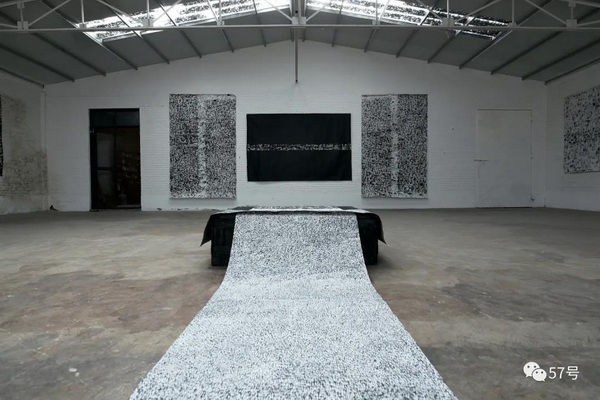
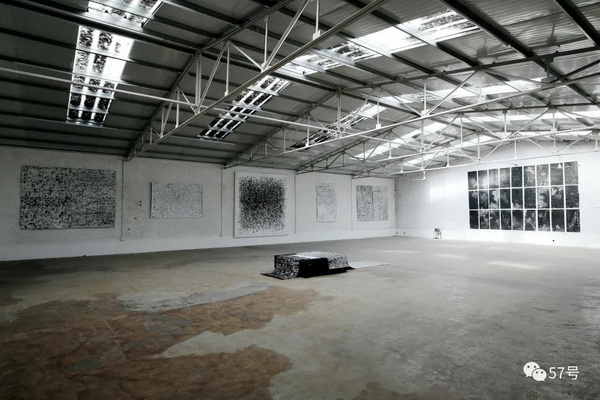
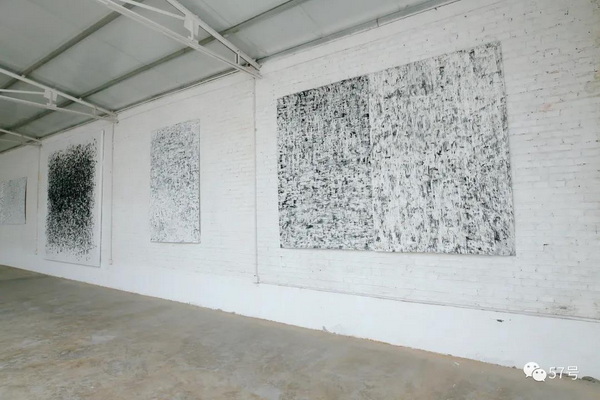
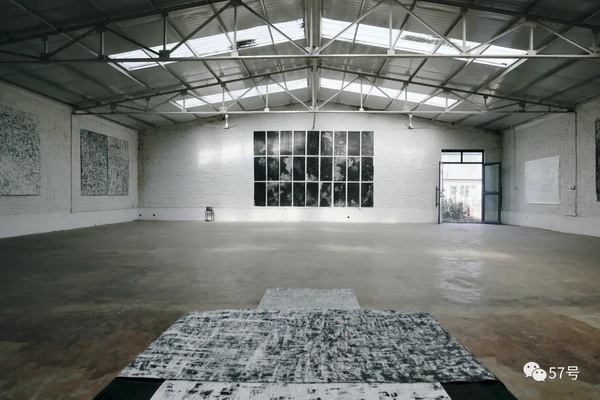
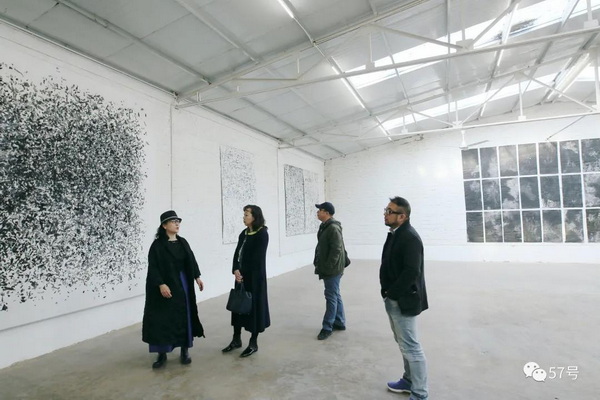
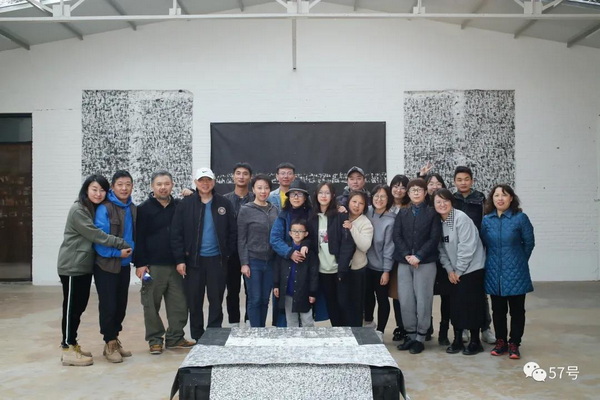
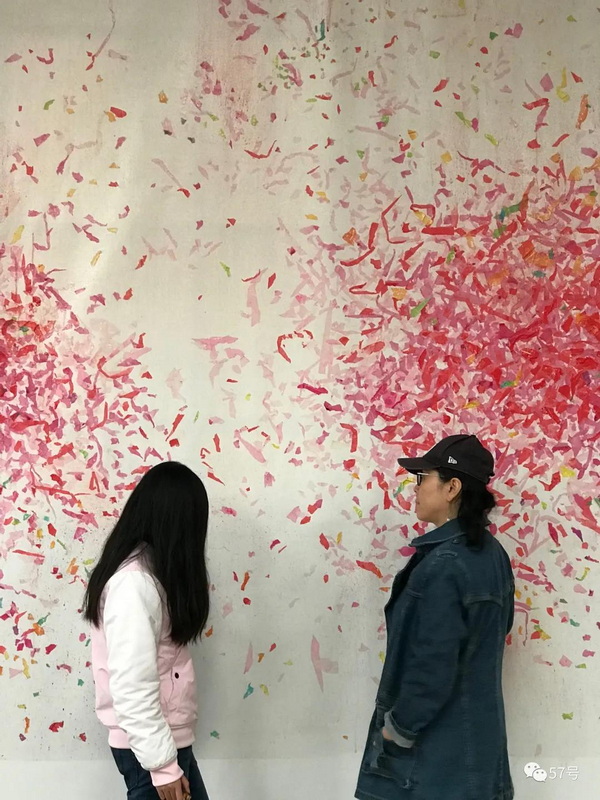
关于艺术家
盖特兰斯(Gerd Leins),德国艺术家,1960年生。是艺术家,也是诗人。既是沉浮商海30载的企业家,也曾作为政治新星被提名汉堡议会候选人。曾是洋洋得意的红灯区酒吧的老板,自己更是“与尔同消万古愁的”忠实践行者。一个喜欢在弯道加速,用300公里的时速,演绎速度与激情的非著名赛车手——无法将其定位在任何一个固定的角色上。在寻觅自我的道路上始终一往无前。
艺术的核心主题,是最终消逝的自我。在他看来,生命,是穿插在“ 无”之间的一个片刻。在这个片刻里是我们的自我意识。这一个片刻是一个孤独的时间段——通过周围的人的存在,使得我们的自我存在得以确认。
目前正在进行的艺术创作是,将画布上面贴好的讣告,用分段遮盖的方式把讣告原始信息逐渐抹去,到最后的完全消失。通过黑色和白色 两种颜料,兰斯将讣告背后的故事和曾经的记忆,进行了信息转化。
最终,我们还有什么存留于世? 一切。但同时,也什么都没留下。无论开端还是结尾——终究灰飞湮灭!
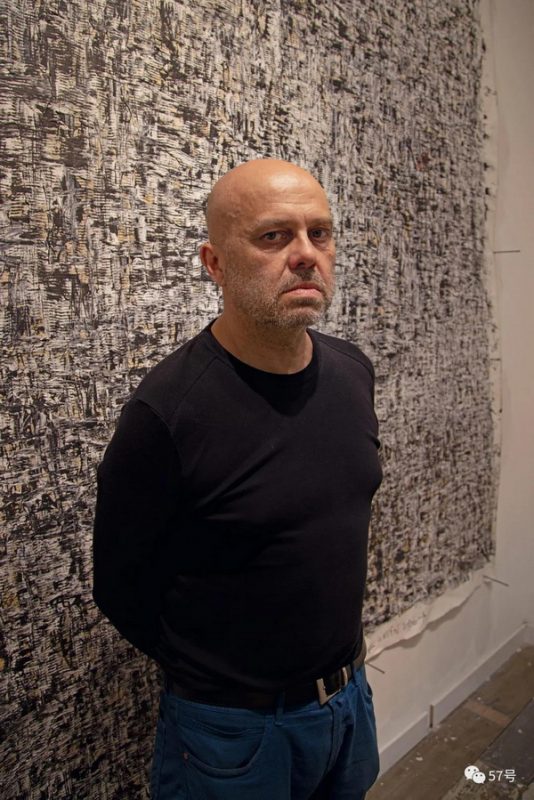
盖特兰斯(Gerd Leins)
倪少峰
1980年至1984年,山东师范大学艺术系美术专业,获学士学位
1990年至1998年,汉堡大学艺术史系艺术史专业,获硕士学位
2009 年汉堡大学亚非学院在读博士生
自2003年起,汉堡大学亚非学院中国语言文化系正式编内教师,主任科目:专业高级汉语、中国美术史
近期展览:
2016年9月 汉堡 Barlach Halle K 《眼见为实》
2017年1月 双人展 山东济南《首届山东(国际)当代艺术展》
出版物:
《罗丹与摄影》,与范梦合著(《艺圃》(吉林艺术学院学报) 1987年1月号)
《美术与摄影》,与范梦合著(《艺圃》(吉林艺术学院学报) 1992年4月号)
《马蒂斯:当代视觉符号的创造者》(上海《文景》杂志 2010年6月号 )
《Chinesisch im Internet》,与 Telse Hack 合著,德国 Buske 出版社,2015年1月
《Facetten des Erinnerns》,主编,德国 Ostasien 出版社,2016年11月
《Lehrbuch der chinesischen Sprache 2》,德国 Buske 出版社,2017年1月
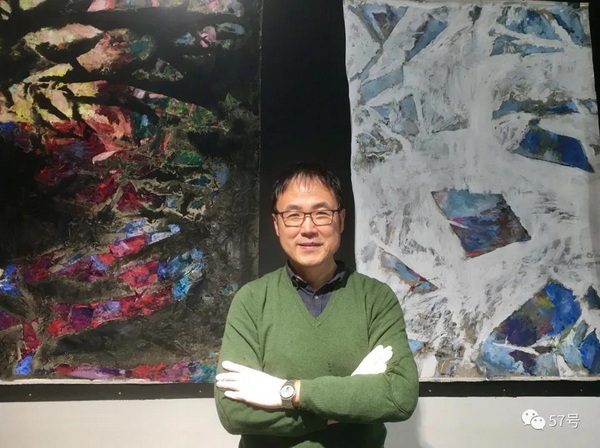
倪少峰

